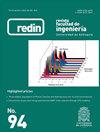Spatial distribution of δ18O in rainwater and groundwater to identify areas of recharge in the Colombian Northwest
IF 0.9
Q3 ENGINEERING, MULTIDISCIPLINARY
Revista Facultad De Ingenieria-universidad De Antioquia
Pub Date : 2023-09-29
DOI:10.17533/udea.redin.20230926
引用次数: 0
Abstract
The understanding of the spatiotemporal variability of the water molecule stable isotopes (δ18O and δ2H) in rain and groundwater has been used in hydrogeology to validate recharge zones. In this study, we analyzed the recharge of four aquifer systems located in northwestern Colombia. This region is characterized by highly complex topography, as the Andes Mountain range splits into three branches, two of them included in the study area. The relation in the variation of values of the δ18O‰ between Precipitation (P) and groundwater (GW) was analyzed through the arithmetic expression P/GW; when P/GW is equal or larger than 1, the recharge is direct, and values less than 1 indicate recharge from regional flows. For the purposes of this research, according to statistics criteria, values between 0.98 and 1.02 are considered as 1. It was found that on Bajo Cauca, Occidente and Urabá, the phreatic aquifers are recharged directly with rainwater or after slight evaporation processes, while the recharge of deep aquifers occur through regional flows. The Valle de Aburrá´s phreatic aquifer is also recharged from distant areas; this occurs because the surface has been impermeabilized by urban processes. The P/GW ratio seems to be useful in identifying recharge processes in regions with higher elevation gradients. In low-lying areas, the applicability of this method should be restricted.哥伦比亚西北部雨水和地下水δ18O空间分布特征及补给区识别
雨水和地下水中水分子稳定同位素(δ18O和δ2H)的时空变化已被用于水文地质,以验证补给区。在这项研究中,我们分析了位于哥伦比亚西北部的四个含水层系统的补给。该地区地形高度复杂,因为安第斯山脉分为三个分支,其中两个包括在研究区域内。通过P/GW的算术表达式,分析了降水(P)与地下水(GW) δ18O‰值变化的关系;当P/GW等于或大于1时,为直接补给,小于1时为区域补给。在本研究中,根据统计标准,将0.98 ~ 1.02之间的值视为1。研究发现,在Bajo Cauca、Occidente和urab地区,浅层含水层的补给主要是雨水直接补给或经过轻微的蒸发过程,而深层含水层的补给则是通过区域径流进行的。aburr山谷的潜水含水层也从遥远的地区得到补给;这是因为城市进程使地表不透水。P/GW比值似乎有助于识别高海拔梯度地区的补给过程。在低洼地区,这种方法的适用性应受到限制。
本文章由计算机程序翻译,如有差异,请以英文原文为准。
求助全文
约1分钟内获得全文
求助全文
来源期刊
CiteScore
2.00
自引率
0.00%
发文量
27
审稿时长
2 months
期刊介绍:
Revista Facultad de Ingenieria started in 1984 and is a publication of the School of Engineering at the University of Antioquia.
The main objective of the journal is to promote and stimulate the publishing of national and international scientific research results. The journal publishes original articles, resulting from scientific research, experimental and or simulation studies in engineering sciences, technology, and similar disciplines (Electronics, Telecommunications, Bioengineering, Biotechnology, Electrical, Computer Science, Mechanical, Chemical, Environmental, Materials, Sanitary, Civil and Industrial Engineering).
In exceptional cases, the journal will publish insightful articles related to current important subjects, or revision articles representing a significant contribution to the contextualization of the state of the art in a known relevant topic. Case reports will only be published when those cases are related to studies in which the validity of a methodology is being proven for the first time, or when a significant contribution to the knowledge of an unexplored system can be proven.
All published articles have undergone a peer review process, carried out by experts recognized for their knowledge and contributions to the relevant field.
To adapt the Journal to international standards and to promote the visibility of the published articles; and therefore, to have a greater impact in the global academic community, after November 1st 2013, the journal will accept only manuscripts written in English for reviewing and publication.
Revista Facultad de Ingeniería –redin is entirely financed by University of Antioquia
Since 2015, every article accepted for publication in the journal is assigned a DOI number.

 求助内容:
求助内容: 应助结果提醒方式:
应助结果提醒方式:


